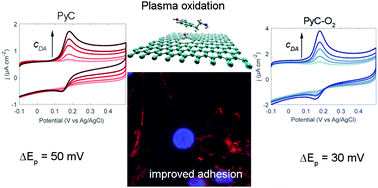SU-8 based pyrolytic carbon for the electrochemical detection of dopamine
Abstract
Here we investigated the electrochemical properties and dopamine (DA) detection capability of SU-8 photoresist based pyrolytic carbon (PyC) as well as its biocompatibility with neural cells. This approach is compatible with microfabrication techniques which is crucial for device development. X-ray photoelectron spectroscopy shows that PyC consists 98.5% of carbon, while oxygen plasma treatment (PyC-O2) increases the amount of oxygen up to 27.1%. PyC showed nearly reversible (ΔEp 63 mV) electron transfer kinetics towards outer sphere redox probe (Ru(NH3)62+/3+), while the reaction on PyC-O2 was quasi-reversible (ΔEp > 75 mV). DA showed both diffusion and adsorption-defined reaction kinetics with fast electron transfer with the ΔEp values of 50 mV and 30 mV, for PyC and PyC-O2, respectively. The strong interaction between the hydroxyl groups on the surface and DA, as confirmed by simulations, facilitates the redox reactions of DA. DA showed a linear response in the measured physiologically relevant range (50 nM–1 μM) and sensitivities were 1.2 A M−1 cm−2 for PyC and 2.7 A M−1 cm−2 for PyC-O2. Plasma oxidation (PyC-O2) improved cell adhesion even more than poly-L-lysine (PLL) coating on PyC, but best adhesion was achieved on PLL coated PyC-O2. Glial cells, neuroblastoma cells and neural stem cells all showed similar behavior.



 Please wait while we load your content...
Please wait while we load your content...